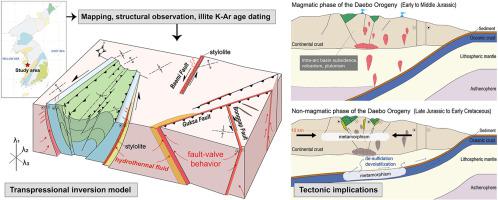当前位置:
X-MOL 学术
›
J. Struct. Geol.
›
论文详情
Our official English website, www.x-mol.net, welcomes your
feedback! (Note: you will need to create a separate account there.)
Mesozoic transpressional structural inversion and synkinematic crustal fluid circulation around the northeastern Chungnam basin, southwestern Korean Peninsula: Tectonic implications
Journal of Structural Geology ( IF 2.6 ) Pub Date : 2024-02-01 , DOI: 10.1016/j.jsg.2024.105070 Yujung Kwak , Seung-Ik Park , Changyun Park , Yungoo Song , Luca Smeraglia
Journal of Structural Geology ( IF 2.6 ) Pub Date : 2024-02-01 , DOI: 10.1016/j.jsg.2024.105070 Yujung Kwak , Seung-Ik Park , Changyun Park , Yungoo Song , Luca Smeraglia

|
This study explores the coupled processes of structural inversion and fluid migration around the northeastern part of the Mesozoic Chungnam Basin in the southwestern Korean Peninsula, focusing on quartz vein systems genetically linked to an orogenic gold deposit. Our results show that the inversion structures reflect the coexistence of strike-slip simple shear and pure shear components caused by NW–SE crustal shortening, leading to a transpressional deformation model. The quartz veins, filling the high-angle faults with a reverse slip component and adjacent hydrofractured wall rocks, represent transient fluid flow related to seismic faulting and fault valving during the inversion. New K–Ar ages of illite polytypes in fault gouges, determined using the Illite-age-analysis (IAA) method, indicate Late Jurassic–Early Cretaceous fault reactivations. Notably, ca. 160 Ma 2M1 illite age from a fault zone filled with an orogenic gold–bearing quartz vein indicates that the inversion and auriferous hydrothermal fluid flow started with a magmatic quiescence in the southern Korean Peninsula likely owing to the flat subduction of the Paleo-Pacific Plate. Our findings suggest that the orogenic gold–bearing vein system was likely sourced from the subcrustal metamorphic fluid in the flat subduction zone of the Mesozoic East Asian Continental margin.
中文翻译:

朝鲜半岛西南部忠清南盆地东北部周围的中生代跨压构造反转和运动地壳流体循环:构造意义
本研究探讨了朝鲜半岛西南部中生代忠南盆地东北部周围结构反转和流体迁移的耦合过程,重点关注与造山金矿床遗传相关的石英脉系统。结果表明,反演结构反映了NW-SE地壳缩短引起的走滑简单剪切分量和纯剪切分量的共存,导致了跨压变形模型。石英脉用反向滑移分量和相邻的液压裂隙围岩填充高角度断层,代表了逆温过程中与地震断层和断层阀门相关的瞬态流体流动。使用 Illite 年龄分析 (IAA) 方法确定的断层凿孔中伊利石多型的新 K-Ar 年龄表明晚侏罗世-早白垩世断层重新激活。值得注意的是,来自充满造山含金石英脉的断层带的约 160 马 2M1 伊利特年龄表明,逆温和含金热液流体流动始于朝鲜半岛南部的岩浆静止,这可能是由于古太平洋板块的平坦俯冲。我们的研究结果表明,造山含金矿脉系统可能来自中生代东亚大陆边缘平坦俯冲带的地壳下变质流体。
更新日期:2024-02-01
中文翻译:

朝鲜半岛西南部忠清南盆地东北部周围的中生代跨压构造反转和运动地壳流体循环:构造意义
本研究探讨了朝鲜半岛西南部中生代忠南盆地东北部周围结构反转和流体迁移的耦合过程,重点关注与造山金矿床遗传相关的石英脉系统。结果表明,反演结构反映了NW-SE地壳缩短引起的走滑简单剪切分量和纯剪切分量的共存,导致了跨压变形模型。石英脉用反向滑移分量和相邻的液压裂隙围岩填充高角度断层,代表了逆温过程中与地震断层和断层阀门相关的瞬态流体流动。使用 Illite 年龄分析 (IAA) 方法确定的断层凿孔中伊利石多型的新 K-Ar 年龄表明晚侏罗世-早白垩世断层重新激活。值得注意的是,来自充满造山含金石英脉的断层带的约 160 马 2M1 伊利特年龄表明,逆温和含金热液流体流动始于朝鲜半岛南部的岩浆静止,这可能是由于古太平洋板块的平坦俯冲。我们的研究结果表明,造山含金矿脉系统可能来自中生代东亚大陆边缘平坦俯冲带的地壳下变质流体。





















































 京公网安备 11010802027423号
京公网安备 11010802027423号